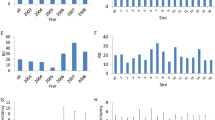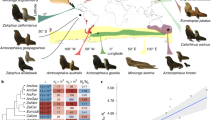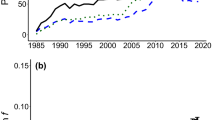Abstract
For species with overlapping generations, the most widely used method to calculate effective population size (Ne) is Hill’s, the key parameter for which is lifetime variance in offspring number (\({V}_{k\bullet }\)). Hill’s model assumes a stable age structure and constant abundance, and sensitivity to those assumptions has been evaluated previously. Here I evaluate the robustness of Hill’s model to extreme patterns of reproductive success, whose effects have not been previously examined: (1) very strong reproductive skew; (2) strong temporal autocorrelations in individual reproductive success; and (3) strong covariance of individual reproduction and survival. Genetic drift (loss of heterozygosity and increase in allele frequency variance) was simulated in age-structured populations using methods that generated no autocorrelations or covariances (Model NoCor); or created strong positive (Model Positive) or strong negative (Model Negative) temporal autocorrelations in reproduction and covariances between reproduction and survival. Compared to Model NoCor, the other models led to greatly elevated or reduced \({V}_{k\bullet }\), and hence greatly reduced or elevated Ne, respectively. A new index is introduced (ρα,α+), which is the correlation between (1) the number of offspring produced by each individual at the age at maturity (α), and (2) the total number of offspring produced during the rest of their lifetimes. Mean ρα,α+ was ≈0 under Model NoCor, strongly positive under Model Positive, and strongly negative under Model Negative. Even under the most extreme reproductive scenarios in Models Positive and Negative, when \({V}_{k\bullet }\) was calculated from the realized population pedigree and used to calculate Ne in Hill’s model, the result accurately predicted the rate of genetic drift in simulated populations. These results held for scenarios where age-specific reproductive skew was random (variance ≈ mean) and highly overdispersed (variance up to 20 times the mean). Collectively, these results are good news for researchers as they demonstrate the robustness of Hill’s model even in extreme reproductive scenarios.
This is a preview of subscription content, access via your institution
Access options
Subscribe to this journal
Receive 12 print issues and online access
$259.00 per year
only $21.58 per issue
Buy this article
- Purchase on Springer Link
- Instant access to full article PDF
Prices may be subject to local taxes which are calculated during checkout




Similar content being viewed by others
Data availability
All results presented here were generated by simulations. R code to conduct the simulations is available in Supplementary Information.
References
Bell G (1980) The costs of reproduction and their consequences. Am Nat 116(1):45–76
Byholm P, Nikula A, Kentta J, Taivalmäki J‐P (2007) Interactions between habitat heterogeneity and food affect reproductive output in a top predator. J Anim Ecol 76:392–401
Caswell H (2001) Matrix population models: construction, analysis, and interpretation, 2nd edn. Sinauer Associates, Sunderland, MA
Charlesworth B (1994) Evolution in age-structured populations, 2nd edn. Cambridge University Press, Cambridge
Crow JF, Kimura M (1970) An introduction in population genetics theory. Harper and Row, New York (NY)
Cushing JM (1994) The dynamics of hierarchical age-structured populations. J Math Biol 32:705–729
Engen S, Lande R, Sæther B-E (2005) Effective size of a fluctuating age-structured population. Genetics 170:941–954
Engen S, Lande R, Sæther B-E, Dobson FS (2009) Reproductive value and the stochastic demography of agestructured populations. Am. Nat. 174:795–804
Hedrick PW (2000) Genetics of populations, 2nd edn. Jones and Bartlett, Sudbury (MA)
Hill WG (1972) Effective size of population with overlapping generations. Theor Popul Biol 3:278–289
Hill WG (1979) A note on effective population size with overlapping generations. Genetics 92(1):317–322
Kruuk LE (2004) Estimating genetic parameters in natural populations using the ‘animal model’. Philos Trans R Soc B Biol Sci 359(1446):873–890
Lande R, Engen S, Saether BE (2003) Stochastic population dynamics in ecology and conservation. Oxford University Press.
Lee AM, Engen S, Sæther B-E (2011) The influence of persistent individual differences and age at maturity on effective population size. Proc Royal Soc B Biol Sci 278:3303–3312
Lee AM, Myhre AM, Markussen SS, Engen S, Solberg EJ, Haanes H, Røed K, Herfindal I, Heim M, Sæther BE (2020) Decomposing demographic contributions to the effective population size with moose as a case study. Mol Ecol 29(1):56–70
McElligott AG, Hayden TJ (2000) Lifetime mating success, sexual selection and life history of fallow bucks (Dama dama). Behav Ecol Sociobiol 48:203–210
Mousseau TA, Fox CW (eds) (1998) Maternal effects as adaptations. Oxford University Press, New York.
Pelletier F, Hogg JT, Festa-Bianchet M (2006) Male mating effort in a polygynous ungulate. Behav Ecol Sociobiol 60:645–654
R Core Team (2021). R: a language and environment for statistical computing. R Foundation for Statistical Computing, Vienna, Austria. https://www.R-project.org/
Reznick D (1992) Measuring the costs of reproduction. Trends Ecol Evol 7(2):42–45
Roff D (1992) Evolution of life histories: theory and analysis. Chapman and Hall, New York
Smith JN (1981) Does high fecundity reduce survival in song sparrows? Evolution 35:1142–1148.
Tuljapurkar S, Steiner UK, Orzack SH (2009) Dynamic heterogeneity in life histories. Ecol Lett 12(1):93–106
Van Noordwijk AJ, De Jong G (1986) Acquisition and allocation of resources: their influence on variation in life history tactics. Am Nat 128(1):137–142
Vindenes Y, Engen S, Sæther BE (2008) Individual heterogeneity in vital parameters and demographic stochasticity. Am Nat 171(4):455–467
Waples RS (2020) An estimator of the Opportunity for Selection that is independent of mean fitness. Evolution 74:1942–1953
Waples RS (2022a) TheWeight: a simple and flexible algorithm for simulating non-ideal, age-structured populations. Methods Ecol Evol 13:2030–2041
Waples RS (2022b) What is Ne, anyway? J Hered 113:371–379
Waples RS, Do C, Chopelet J (2011) Calculating Ne and Ne/N in age-structured populations: a hybrid Felsenstein-Hill approach. Ecology 92:1513–1522
Waples RS, Antao T, Luikart G (2014) Effects of overlapping generations on linkage disequilibrium estimates of effective population size. Genetics 197:769–780
Waples RS, Feutry P (2022) Close-kin methods to estimate census size and effective population size. Fish Fish 23:273–293
Williams GC (1966) Natural selection, the costs of reproduction, and a refinement of Lack’s principle. Am Nat 100(916):687–690
Wilson AJ, Nussey DH (2010) What is individual quality? An evolutionary perspective. Trends Ecol Evol 25(4):207–214
Wright S (1931) Evolution in Mendelian populations. Genetics 16(2):97–159
Wright S (1938) Size of population and breeding structure in relation to evolution. Science 87:430–431
Acknowledgements
The author is grateful to Bill Hill for many insightful discussions over the years, relating to effective population size as well as other topics. I thank Steinar Engen and Bernt-Erik Saether for useful discussions. Per Erik Jorde provided comments that substantially improved the manuscript.
Author information
Authors and Affiliations
Corresponding author
Ethics declarations
Competing interests
The author declares no competing interests.
Additional information
Publisher’s note Springer Nature remains neutral with regard to jurisdictional claims in published maps and institutional affiliations.
Associate editor: Armando Caballero.
Supplementary information
Rights and permissions
Springer Nature or its licensor (e.g. a society or other partner) holds exclusive rights to this article under a publishing agreement with the author(s) or other rightsholder(s); author self-archiving of the accepted manuscript version of this article is solely governed by the terms of such publishing agreement and applicable law.
About this article
Cite this article
Waples, R.S. Robustness of Hill’s overlapping-generation method for calculating Ne to extreme patterns of reproductive success. Heredity 131, 170–177 (2023). https://doi.org/10.1038/s41437-023-00633-6
Received:
Revised:
Accepted:
Published:
Issue Date:
DOI: https://doi.org/10.1038/s41437-023-00633-6



